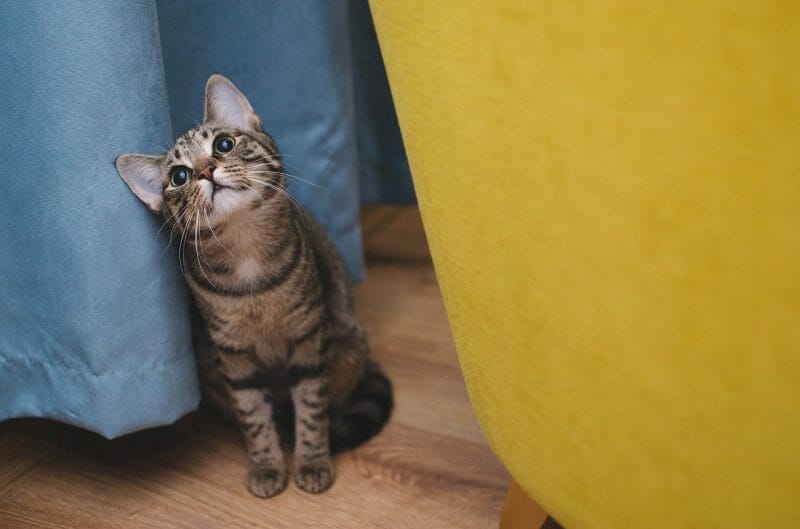Looking for ways to hide your beloved cat from your landlord? We’ve got you covered!
While it may seem like a daunting task, there are several strategies you can employ to keep your furry friend under the radar.
From implementing clever hiding spots to minimizing any telltale signs of a pet, we’ll provide you with practical tips to ensure your cat remains a secret from your landlord.
Keep reading to discover creative solutions for keeping your pet safe and sound, while keeping your landlord none the wiser.

Noise Reduction Solutions: Ways to keep your cat from being heard by the landlord
Cats can be quite vocal creatures, especially during the night or when they are feeling anxious or playful.
To maintain a peaceful living environment and avoid any potential conflicts, it’s essential to find effective noise reduction solutions. In this section, we will explore various strategies to help keep your cat from being heard by your landlord.

1. Provide a cozy space
One of the simplest ways to reduce noise caused by your cat is to create a comfortable and secluded area where they can retreat. This space should be equipped with a cozy bed, toys, and scratching posts to keep your cat entertained and occupied.
Encouraging your cat to spend time in this designated area can help minimize their movements and noise levels in the rest of the house.
2. Use soundproofing materials
Another effective solution for reducing noise is to incorporate soundproofing materials into your living space. Install acoustic panels on the walls or use sound-absorbing curtains to minimize sound transmission.
These materials can help absorb and dampen the noise created by your cat, ensuring that it doesn’t travel beyond your apartment or house.
3. Train your cat
Training your cat to minimize excessive vocalization can significantly reduce noise levels in your home. Positive reinforcement techniques can be used to teach your cat to be quiet or to communicate through non-vocal means, such as using a bell or scratching post.
Consistency and patience are key when training your cat, and over time, they will learn to be more quiet and less disruptive.
4. Engage your cat in play and exercise
Cats often become more active and vocal when they’re bored or have excess energy. By engaging your cat in regular play and exercise sessions, you can help them release pent-up energy and reduce their inclination to make noise.
Use interactive toys, scratching posts, or laser pointers to provide mental and physical stimulation for your cat.
5. Consult a veterinarian
If your cat’s excessive noise continues to be a problem, it’s advisable to consult with a veterinarian.
Excessive vocalization could be a sign of an underlying medical issue or behavioral problem that requires attention. Your veterinarian can provide guidance and recommend appropriate remedies or solutions to address the excessive noise.
6. Consider calming aids
There are various calming aids available in the market that can help reduce stress and anxiety in cats, which can contribute to excessive vocalization.
These aids include pheromone diffusers, calming collars, or natural remedies like chamomile or lavender.
Consult with your veterinarian to determine which calming aids are safe and suitable for your cat.
7. Communicate with your landlord
If you’ve tried various noise reduction strategies and your cat’s vocalizations continue to be a concern, it’s essential to maintain open communication with your landlord.
Explain the steps you have taken to address the issue and assure them that you are actively working on finding a solution.
Building a positive relationship with your landlord and addressing their concerns can go a long way in maintaining a harmonious living environment.

Odor Control Strategies: Tips to prevent your cat’s scent from being noticed
To keep your home smelling fresh and clean, here are some odor control strategies to prevent your cat’s scent from being noticed.
1. Regular litter box maintenance
The first and most important step in controlling cat odor is to maintain a clean litter box. Cats are known for their cleanliness, and they prefer to have a clean and odor-free litter box.
Scoop the litter box at least once a day to remove any waste, and completely change the litter and clean the box once a week. Consider using a litter box with a lid and a carbon filter to help trap odors.
2. Choose the right cat litter
Not all cat litters are created equal when it comes to odor control. Opt for clumping cat litter that is specifically designed to neutralize odors.
Look for litters that contain activated charcoal or baking soda, as these ingredients are known for their odor-absorbing properties. Experiment with different litters to find the one that works best for you and your cat.
3. Maintain proper ventilation
Good airflow is essential in keeping cat odors at bay. Make sure there is sufficient ventilation in the area where the litter box is located. Consider using an air purifier or opening windows to allow fresh air to circulate.
Additionally, using fans or dehumidifiers can help reduce moisture and prevent the growth of bacteria that contribute to unpleasant odors.
4. Clean up accidents promptly
If your cat has an accident outside of the litter box, it is crucial to clean it up promptly. Cat urine contains ammonia, which becomes more pungent as it breaks down.
Use an enzymatic cleaner specifically designed for pet accidents to effectively remove the odor. Avoid using cleaners with ammonia or vinegar, as these can actually enhance the scent to your cat’s sensitive nose.
5. Add odor-absorbing materials
There are various natural odor-absorbing materials that can help neutralize cat odors. Place a bowl of activated charcoal near the litter box or sprinkle baking soda on the litter to absorb odors.
You can also use air fresheners or odor-neutralizing sprays specifically formulated for pet odors, but be cautious to choose products that are safe for cats and won’t cause any respiratory issues.
6. Regular grooming
In addition to controlling litter box odors, regular grooming of your cat can help minimize any lingering smells.
Brushing your cat regularly helps remove loose fur and dander, which can contribute to unpleasant odors. If your cat has a specific scent, consider using pet-safe wipes or sprays to freshen them up between baths.
7. Consider a litter box enclosure
If you are still struggling with cat odors despite thorough cleaning and maintenance, you may want to consider investing in a litter box enclosure.
These enclosures are designed to contain litter box odors and provide privacy for your cat. They often come with filters or exhaust fans to further minimize odors.
Ensure the enclosure is large enough for your cat to comfortably enter, turn around, and use the litter box.
Creating a Cat-Safe Zone: Designing a designated area to keep your cat away from the landlord’s sight
Having a cat in an apartment can sometimes present challenges, especially if your landlord doesn’t allow pets. However, there are ways to create a cat-safe zone, providing a designated area where your feline friend can comfortably live without causing any disturbances or attracting the landlord’s attention.
Here are some tips for designing a cat-safe zone:
1. Choose a Quiet Area:
Select a quiet area in your apartment where your cat can feel safe and undisturbed. This could be a spare bedroom, a corner of the living room, or even a walk-in closet. Make sure the area is away from any noisy appliances or high-traffic areas.
2. Set Up a Cat Condo or Tree:
Provide vertical space for your cat to climb and explore by setting up a cat condo or tree in the designated area. This will not only give your cat a place to play but also help them feel secure and content.
3. Create Hiding Spots:
Cats love having hiding spots where they can retreat to when they feel overwhelmed or need some alone time. Place cozy cat beds, blankets, or cardboard boxes in the cat-safe zone to create these hiding spots for your feline companion.
4. Provide Interactive Toys:
Keep your cat entertained and prevent boredom by providing interactive toys in the designated area.
Puzzle toys, feather wands, and treat-dispensing toys can keep your cat mentally stimulated and physically active, reducing the chances of them venturing out into unauthorized areas.
5. Set Up a Litter Box:
It’s essential to provide a litter box in the cat-safe zone to ensure your cat has a designated area for their toileting needs. Make sure to keep the litter box clean and odor-free to encourage regular use.
6. Install Scratching Posts:
Cats need to scratch to maintain their claws and mark their territory. Prevent your cat from damaging furniture or walls by installing scratching posts in the designated area.
This will divert their attention away from other surfaces and provide an appropriate outlet for their scratching instincts.
7. Ensure Proper Ventilation and Lighting:
Make sure the cat-safe zone has proper ventilation and natural lighting. Cats thrive in environments with fresh air and access to sunlight.
If the area lacks natural light, consider using artificial lighting to create a bright and welcoming space for your furry friend.
8. Keep the Area Clean:
Maintain cleanliness in the cat-safe zone by regularly vacuuming, dusting, and washing cat bedding.
This will not only ensure a hygienic environment but also help minimize odors that may attract unwanted attention from the landlord or neighbors.
9. Utilize Soundproofing Techniques:
If your cat tends to be noisy or vocal, consider utilizing soundproofing techniques in the cat-safe zone. Use thick curtains, rugs, or acoustic panels to absorb sound and prevent noise from carrying beyond the designated area.
How can I hide my cat from my landlord?
It is not recommended to hide your cat from your landlord, as it can lead to serious consequences. It’s best to be honest and upfront with your landlord about having a cat. Discuss the possibility of having a pet with them and try to come to a mutual agreement. However, if you still want to hide it, follow the tips from this article.
What should I do if my landlord doesn’t allow pets?
If your landlord doesn’t allow pets, you can try negotiating with them. Offer to pay a pet deposit or an increased rent amount. Provide references from previous landlords who can vouch for your responsible pet ownership. If all else fails, you may need to consider finding a new pet-friendly rental.
What are the risks of hiding a pet from the landlord?
Hiding a pet from your landlord can have serious consequences. If your landlord finds out about it, they may evict you or impose hefty fines. It’s always better to be honest and transparent with your landlord to avoid any legal issues or strain in the landlord-tenant relationship.
Conclusion
Finding ways to hide a cat from your landlord can be a challenging task, but not impossible. By following some clever strategies and utilizing effective techniques, you can increase your chances of keeping your furry companion a secret.
Remember, it is important to respect your landlord’s rules and regulations, as breaking them may have serious consequences. Consider open communication with your landlord or exploring pet-friendly housing options in the long run. Additionally, proper cat care, including regular grooming and odor control, can go a long way in keeping your cat discreet.
Ultimately, with careful planning and responsible pet ownership, you may be able to enjoy the company of your beloved feline friend without jeopardizing your living situation.


